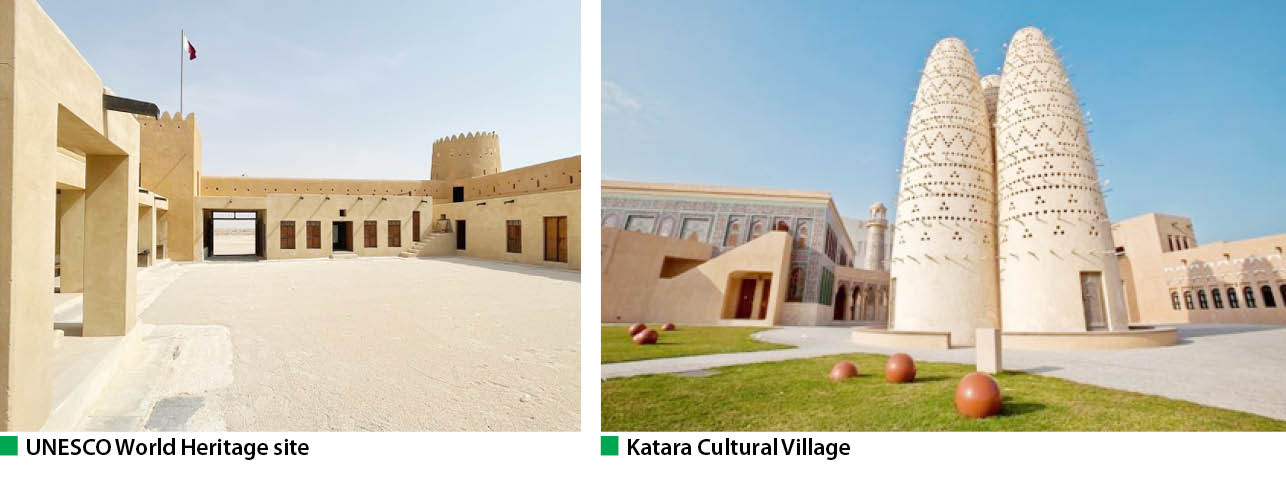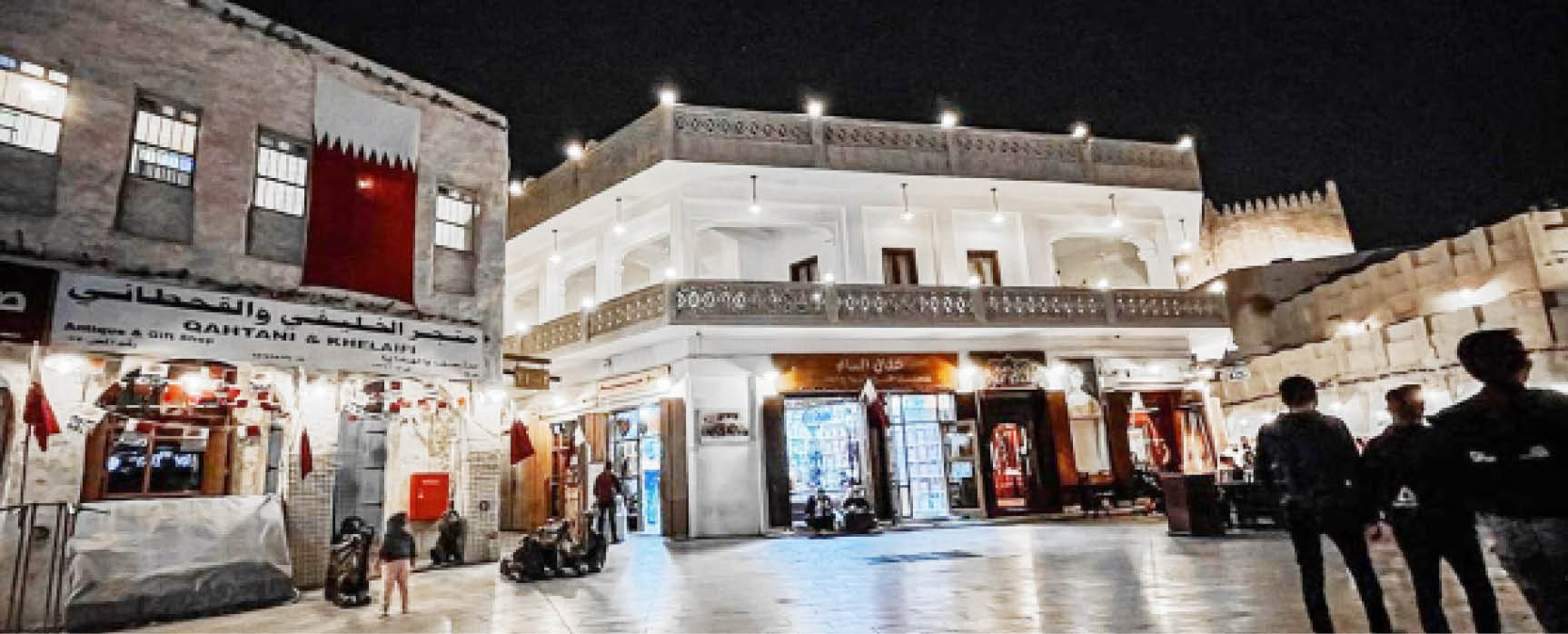Located in the heart of the Middle East, Qatar is a unique destination that embraces modernity while remaining steep in tradition.
Qatar, a gateway to the world, with around half of the world’s population within a five-hour flight radius, has a history that stretches forwards and backwards. There is spectacular architecture everywhere, from public art galleries to skyscrapers and minarets.
This is a compact country on a peninsula in the Arabian Gulf, but the possibilities within are limitless. It is a melting point that is home to a huge expatriate population – around 160 nationalities in total, with the Qataris making up just about per cent.
Few decades ago, Doha was a small town in the desert, but it’s now a metropolis which is rich with history, art and industry. With more than 560km of coastline that frames the desert, it is home to beaches, lagoons, inland sea and mangrove island that thrive in the salty gulf waters where pearl divers and fishermen have made their livelihoods for centuries.
Nigeria needs massive investments to avert a deepening crisis in education
Emefiele’s return from ‘exile’: Matters arising
In Qatar, you will find two very different types of deserts. In the North, there is the hamada or rocky desert, a surreal landscape of ethereal rock formations and monoliths; and in the South, rolling sand dunes curve towards the turquoise waters of the Khor Al Udaid, also known as the Inland Sea.
The desert landscape is spectacular on the country’s West coast, particularly in Ras Abroug, where unusual limestone formations make a dramatic terrain. At nearby Zekreet, American artist, Richard Serra’s, world-renowned sculpture of the East-West/West-East emerges breathtakingly from the sands.

Qatar is one of the rare places in the world where the desert meets the sea, and the best time to visit is between October and May when the temperatures are moderate. During this time, you can experience the traditional desert lifestyle with activities such as camel riding and spending a night in a Bedouin tent.
Dressing conservatively is recommended in Qatar, especially in historic neighborhoods and places of worship, like wearing clothing that covers shoulders, arms and legs.
It is a warm and friendly country and you will come across many people who will greet you with a smile and wish you well. Alcohol is served in licensed places to those over 21 years of age. However, public intoxication is not acceptable. The use of illegal drugs is strictly prohibited.
In Doha, the easiest way to get around is the new metro system. There are three lines covering most of the city, with extensions on the way. It is safe, fast, cheap and clean. In fact, Qatar is an extremely safe country. In an online database, Numbeo’s 2022 rankings, Qatar is rated the safest country in the world. So, you can travel safely and with peace of mind to Qatar.
There is also a comprehensive bus service and tax services such as Uber and Careem.
Doha is blessed with lots of diverse locations that you can visit with its cultural life divided across three distinct areas: Souq Waqif, Katara Cultural Village and Msheireb Downtown Doha.
In the heart of the city is its oldest market, Souq Waqif. Once it was a hub for trading sheep and goats, but after it was rebuilt, it became a tourist hotspot and a link to the country’s past. Its tangled warren of streets and lanes are home to stalls full of clothes, antiques, spices, jewellery and food.
Talking about food, Shay Al Shoomos is a popular spot with the locals when you want to eat. The first restaurant to be owned and operated by a Qatari woman, its known for its flavoursome, homely vibe and authentic Qatari food. You can also visit The Pearl where you will be spoilt with different choices of cafes and diners.
After eating, make your way to the Katara Cultural Village which is the city’s multicultural hub. The village got its name from Katara which is the ancient name for Qatar. It is all about art, history and culture. Here, you can explore the collection of outdoor sculptures and artwork, the magnificent Greek styled amphitheatre, mosques, amongst other interesting sites. There is a public beach if you want to swim. There is also an opera house, a maritime museum and a planetarium.
Msheireb Downtown is right next to Souq Waqif and it’s full of restaurants, boutiques and museums. It is a carefully planned district that came about as a total rethink of the city centre.
Qatar has more than its share of museums which tell the story of the country and region at large; object by object. Everything in the museums tells a story: from a priceless pearl to even the origin of number plates for cars. The museums are a great way to learn a little about Qatar’s culture and history.
At the National Museum you will learn about the country’s nature and wildlife, the history of trading and pearling and the huge cultural shift of the last few decades. The museum gives voice to the country’s culture and heritage through artefacts, oral history, music, films,and artworks.
The museum houses approximately 8,000 objects telling the story of Qatar, past, present and future from archeological artefacts to household items, from pearl diving and desert life to oil and ambition. It is located on Museum Park Street on the Southern side of the Corniche in Doha.
The Museum of Islamic Arts is one of the world’s premiere institutions of Islamic arts where you can deepen your knowledge on Islamic arts. It houses one of the finest collections of Islamic arts in the world, including ceramics, carpets and manuscripts spanning over a thousand years.
The Msheireb museums are spread across four houses, each reconstructed to reflect a different facet of Qatar’s history. The first is a carefully restored early 20th Century Qatari family home; the second is the site of the humble former headquarters of an oil company which shows the country’s 20th Century transformation into an energy powerhouse; the third brings visitors up to speed with the country’s recent past, present and future. Finally, the fourth is a house packed full of artefacts telling the story of the impact of slavery on the region.
Another museum is the FBQ Museum where you will find the imposing stone palace that houses the Sheikh Faisal Bin Qassim Al Thani Museum (FBQ for short). It is one of the world’s largest private museums; telling the story of Qatar through the lens of one of its richest entrepreneurs. In there, you will see a large selection of the sheikh’s own personal interests on display, including over 600 vintage cars. Qatar National Library is a contemporary hub of knowledge. It is just beyond books as it hosts events, exhibitions and cultural workshops. In there are rare books, manuscripts and other materials related to Arab-Islamic civilisation.
Arab Museum of Modern Art offers a vital alternative of Arabic art. It houses one of the largest collections of sculptures and paintings by Arab artists in the world. The gallery has a permanent collection, a library and hosts regular exhibitions.
Arab Postal Stamps Museum collects artefacts from 22 Arab countries. It is a cultural survey showcasing the design, history and commerce of a vibrant region.
Meanwhile, Qatar’s spectacular public arts are not confined to galleries or museums. The country has a penchant for sculptures. Around every corner you will find works by local artists and world-renowned artists, from the quirky to the moving, from the laneways of Souq Waqif to the sands of the desert.
Walking the lanes of Souq Waqif, you are bound to run into Le Pounce, an avant-garde piece by French artist, Cesar Baldaccini. It is a two-storey gold thumb sticking out of the ground.
The 14 sculptures of British artist, Damien Hirst’s, The Miraculous Journey, right outside the women and children’s hospital at Sidra Medicine depict various stages of the development of a foetus.

Over at the Qatar National Convention Centre (QNCC) you will see a giant spider in marble, bronze and stainless steel; its spindly legs straddling the foyer.
Subodh Gupta’s Gandhi’s Three Monkeys on the waterfront in Katara Cultural Village takes the form of three giant heads to portray different facets of war and peace.
There is more to do at the Hamad International Airport than taking a cup of coffee and waiting to travel. There is a plethora of sculptures to check out. The airport’s authorities work closely with Qatar Museums on its ever-expanding art collection from local and international artists, enlivening the space and enriching travellers’ experiences.
In the airport’s main hall, surrounded by food and retail, you will find Lamp Bear, a huge sculpture that has become something of a mascot for the airport. At metres tall, the bronze bear is a playful statement that humanises the space.
You will find oversized, hollow bronze sculptures which double as playgrounds, inviting children and adults to explore the inside of the toy-like figures.
Meanwhile, beyond Doha, there are other cities where one can find interesting places to visit.
The third largest municipality in Qatar, Al Rayyan, which is roughly 10 kilometres North of Doha, is derived from an Arabic phrase that means “irrigation.” The city is a must-visit destination, especially for tourists interested in learning about local culture, as it is home to some of Qatar’s most well-known attractions. Al Rayyan has a wide variety of galleries, museums, retail centres and a fantastic culinary scene, in addition to sharing borders with the largest communities in the nation. Every traveller may find something to do in the city. Al Rayyan has everything, whether you’re interested in international cuisine, culture, art or history.
Al Wakra, which is located to the North of Doha, is well-known for being a top fishing location with a number of fantastic tourist attractions. This city has a lot more to offer than travellers may know, including stunning parks, a wide variety of historical monuments and immaculate beaches. The city is a well-known location for pearl diving and is home to many prosperous merchants. Souq Al Wakra, which contains a number of courtyards and lanes that have been there for years, is one of the best spots to visit in this city. The Souq Al Wakrah is the ideal location to enjoy the city’s classic charm.
Umm Salal Mohammed is a village in Umm Salal, one of Qatar’s smallest municipalities, yet it has a lot to offer visitors. Visitors who have been here before return time and time again since the village offers so many lovely attractions such as lovely parks, historical sites, playgrounds, and entertaining excursions. Barzan Olympic Park, Barzan Towers, Umm Salal Stadium, and the most well-known market, Umm Salal Central Market, are a few locations that tourists might put on their bucket lists.
Khawr Al Udayd, which is situated in South East Qatar close to the Saudi Arabian border, is a fantastic place to visit. It also has a stunning beach, which is its most well-known feature, and is recognised as one of UNESCO’s World Heritage Sites. The sand dunes in the vicinity are among the most beautiful and are definitely worth seeing. Tourists should reserve trips to visit this location because only qualified drivers with the right vehicles can get there. A few of the most exciting activities include 4X4 dunes drives, sand skiing, camel rides and barbecues.
Al Khor’s lengthy, intriguing history-which predates Doha’s-is among its most intriguing features. Although the city has a population of just over 30,000, some of Qatar’s most outstanding tourist attractions draw visitors from around the globe. There is so much to discover in this city, from grand parks to immaculate beaches to cultural and natural attractions. Al Thakira, Al Khor Park, and Purple Island are a few locations you shouldn’t miss.
Some of the most successful foreign businesses are based in Ras Laffan Mechanical City (RLIC), which is 80 kilometres North East of Doha. It is understandable why businesspeople and entrepreneurs frequent the town. Ras Laffan Mechanical City is one of the largest industrial export places in the world and plays a vital part in the commercial world. It is tucked away along the Northern coast of the Qatari landmass.
Mesaieed is brimming with entertaining activities that tourists of all interests and ages would be delighted to experience. This town offers a lifetime of travel memories, from its stunning beaches to its spectacular sand dunes to its fascinating history and culture.
One of Qatar’s most distinctive and cutting-edge cities, Mesaieed, is completely apart from the others. In fact, it is one of the Middle Eastern cities renowned for being the main industrial centre and petroleum hub.
Madinat Al-Shamal, which is in Qatar’s most Northern region and founded in the 1970s, is one of the least populous towns in the country. The town is one of the most impressive and famous in Qatar; with a variety of impressive sights to visit, including deserted fishing villages, clean beaches, archaeological monuments and scenic natural areas. It is one of the most stunning deserted settlements in Qalaat al Thaqab, with lovely houses influenced by Islamic architecture.
Al Zubara’s past as a pearl-fishing town and commerce harbor in the 18th and 19th centuries is fascinating. It is now Qatar’s largest archaeological marvel and a UNESCO World Heritage Site since 2013. Al Zubara, which is roughly 100 kilometres North West of Doha, was established in the 18th Century and has grown to be one of the biggest and most important cities in the region. Visitors can visit mosques, defensive structures, historical ruins and a lovely market.
The most prominent fishing area in Qatar is Al Ruwais, which is well-known for its collection of historic fishermen’s huts. Travellers can discover a variety of attractions in this city, including its ancient structures, the port and the neighbouring Jassasiya Carvings, which is actually its most breathtaking sight. Exploring the Jassasiya Carvings, which date back to 1500BC, is a truly wonderful experience. For those interested in historical sites and the legends around them, Al Ruwais is the ideal destination.
Dukhan, which is roughly 80 kilometres from Doha and became well-known after oil was discovered, is one of the most significant industrial cities in Qatar. Some of its main draws include its amazing beaches, lovely sands, and canals, which make it a must-visit summer destination for tourists looking for ideal family holidays packed with exciting adventures. Although Dukhan, located inside the Al Shahaniya municipality, is not as well-known as its neighbouring cities, it nevertheless boasts its fair share of well-known sights that will undoubtedly make a vacation there memorable. Some of the city’s biggest tourist attractions include Dukhan Beach and Dukhan Masjid.
All said and done, Qataris are welcoming and helpful, they do expect foreigners to respect cultural and religious customs, as well as to dress and behave conservatively in public. Feel free to behave anyway you like while at your house or another private location.
The nation has an established social services system and a high level of living as a result of its oil resources. Both the anniversary of the ruler’s accession to power and the day Qatar gained independence from Great Britain in 1971 are observed as national holidays. In public spaces and regional media, the national flag, the state seal, and pictures of the leaders are prominently displayed.



